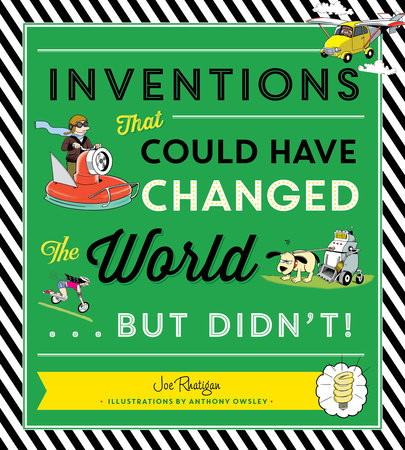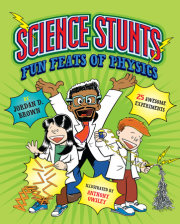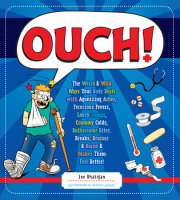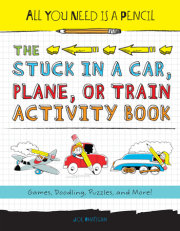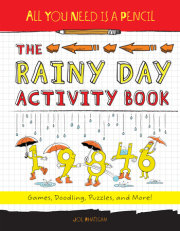From "Smell-O-Vision" to a motorized pogo stick and an edible smartphone case, this romp through Patent Office records is a hilarious tribute to misapplied ingenuity."The world is bursting with ideas," Rhatigan observes. "Unfortunately, not all of these ideas are good." In support, he digs up dozens of unlikely proposals—some of which, like Henry Ford's early Quadricycle and Thomas Edison's Talking Doll were harbingers of truly world-changing innovations. Most, though, like the Reid Flying Submarine, 19th-century rocking bathtubs, a suggestive party-game version of cup-and-ball played at waist level and the aforementioned movie theater "Smell-O-Vision" (and a competing technology, "AromaRama") never got off the ground due to obvious design flaws, expense or just inadequate marketing. Still, all were concocted in a spirit of enterprise, and by way of a hat tip, the author names nearly all of their inventors, renowned or otherwise. Owsley's cartoon visualizations of selected inventions in action join original patent drawings and occasional photos to provide comical commentary as much as to clarify physical and functional details. Casual browsers will come away mightily amused; would-be inventors will find here fresh inspiration, as well as encouragement to give their own wildest ideas a try.
-Kirkus Reviews
For every successful invention, there are a lot of near-misses, dozens of which Rhatigan collects in this entertaining sidewise view of history, which includes b&w illustrations from actual patent applications as well as color cartoons from Owsley. Inventions that didn't get off the ground include a parachute coat (the inventor died testing its effectiveness), a bed that ejects its sleeper to wake him or her, a "Portable Baby Cage" that hangs from the outside of a window, and a rocking bathtub ("no matter what the advertisements said, water got everywhere"). Despite cataloguing a great many failures, Rhatigan challenges readers to try their hands at inventing; as Thomas Edison puts it, in one of serveral featured quotations, "Just because something doesn't do what you planned it to do doesn't mean it's useless."
-Publishers Weekly
For each new innovation that revolutionizes the way people live, there are countless failures--ideas that seemed full of promise but flopped for any number of reasons. Rhatigan asserts that the most compelling stories of invention can be found among these "losers." Young readers will be tickled by descriptions of inventions such as a nineteenth-century bed that catapulted sleepers onto the floor when it was time to wake up; an extremely dangerous motorized pogo stick; and the iPotty, a training toilet for toddlers that features an iPad holder. Owsley's comical cartoon illustrations, along with historical diagrams of some of the inventions, add to the fun. Chapters are divided into broad categories, including designs for transportation, for entertainment, for parents and pet owners, and for eliminating daily inconveniences. Rhatigan includes a brief explanation of how the patent process works and why it exists and posits questions for fledgling inventors to consider about the potential of their ideas. This engaging book holds up innumerable examples of how both trying and failing are avoidable parts of progress.
-Booklist
Opening with a discussion of inventions that weren't as effective as promised, Rhatigan examines these, seeing them as steps toward innovations that did work-an important lesson for students. The inclusion of actual patent drawings offers insight into the patent process as well as humorous commentary. Readers will enjoy the wide variety of craziness, organized to show that mixed among the many unknown inventors are famous names such as Thomas Edison and Buckminster Fuller, who each had their share of unsuccessful projects. A scattering of photos brings a connection to the real world and contrasts dramatically with the abundance of cartoon drawings intended to enhance the absurdity of some inventions. The layout is busy with random splashes of primary colors to distinguish the vignettes. VERDICT This book will be of interest to curious kids with an engineering bent, though it is not an essential purchase.
-School Library Journal
Thomas Edison, Henry Ford, and Ernö Rubik (creator of the Rubik's cube) are the names we associate with particular inventions, but they weren't the first to design or create light bulbs, gasoline-powered cars, or three-dimensional puzzles. For every successful creation, the patent literature is full of designs and ideas that never found broad acceptance. Some just seem bizarre, whereas others may have been insufficiently perfected or overly complicated. Structured around images from old patents combined with wacky illustrations, this book presents the reader with a series of inventions that didn't quite make the big time. These include pet diapers, baby food for teenagers, and all manner of transportation devices. Some designs appear to have been just ahead of their time—and perhaps were a source of influence for the gadgets regularly found in science fiction and spy movies. In some cases, though, you'll be left scratching your head. It is hard to believe, for example, that a gas-powered pogo stick was conceived, much less marketed to the public. Not only was this the case, but the authors provide a link to the commercial that was used (unsuccessfully) to try to sell it. This is a fun book to browse through and certainly one to consider for budding inventors.
-Science Magazine





